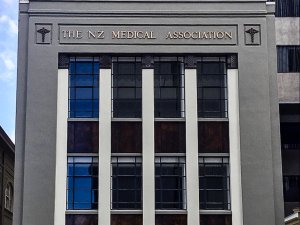Otolaryngologist, head and neck surgeon Francis T. Hall discusses the evaluation of thyroid nodules, which primarily aims to determine the likelihood of malignancy. He then reviews the treatment of thyroid nodules and thyroid cancer, including recent advances in management
New health system rises, NZMA sinks
New health system rises, NZMA sinks

POLICY PUZZLER
New Zealand lacks ground rules for how interest groups should participate in government policy, writes Tim Tenbensel
The brave new world of the new health system has dawned.
In this column, however, my focus is in the rear-view mirror at the demise of the NZMA. Alongside the demise of DHBs, the association’s fate provides a fascinating moment within the health policy history of Aotearoa New Zealand.
In 1940, the NZMA was powerful enough to divert the reforming Government of Michael Joseph Savage from universal, State-funded access to primary medical care.
Those, however, were the glory days of its policy influence. In recent commentary on its imminent demise, the common themes have been decay and the narrative of an organisation that had become out of step with its constituency.
The Spinoff’s “obituary” reminded me that the NZMA in 1989 took Don Matheson – later a key architect of the Primary Health Care Strategy – to court for having the temerity to set up a service that didn’t charge patients any copayments.
More recently, other members threw in their ticket in dismay at the NZMA’s stance on medicinal cannabis regulation.
However, the more fundamental reason behind the slow decline and demise of the NZMA is that it had no clear role in health policy. This becomes clear when you compare it with its counterparts overseas.
On my first research visit to Canada in 2005, I encountered representatives of the Ontario Medical Association. They seemed to have almost as many policy analysts on staff as the Ontario Ministry of Health. Their influence on health policy is longstanding and wide-ranging. Very few government policy initiatives see the light of day without the blessing of the OMA.
In other countries, medical associations have played hardball with governments in policy conflicts.
In the late 1990s, the Australian Medical Association mounted a concerted campaign to oust a federal health minister.
The American Medical Association was a key player throughout the 20th century in resisting moves towards universal healthcare financing in the US. Fear of the spectre that is “socialised medicine” remains core to the AMA’s identity.
All this raises the question of whether (and how well) these organisations represent their constituencies. In each country, many medical professionals would have disagreed with the policy stances of their medical association. But, for the leadership of these organisations, their number one priority is to advance and protect their members’ economic interests.
The problem for the NZMA was that there is little that binds together the interests of specialists and primary care doctors.
The NZMA’s demise raises questions about the significance of interest groups in health policy, and in democratic processes more generally.
Back in the 1990s, when I was a postgraduate student, I was a teaching assistant on a single course dedicated to the topic of interest groups and policy. For some time, there had been lively debate among political scientists about whether or not interest groups had a productive role to play in democratic policymaking. Some argued interest groups had an essential function in a democracy as the channels by which public input helped shape policy decisions in between elections. Most who argued this were American political scientists trying to explain to the rest of the world what really made American democracy great.
Other political scientists at the time, however, noticed that policy decisions were often shaped by a tight policy community, which included government agencies working closely with key sector interest groups.
Membership of these policy communities generally excluded other groups with a “stake” in the policy area. Sometimes these arrangements were more about developing stable processes for handling predictable conflicts.
Readers who lived in New Zealand, Australia or the UK in the 1970s will remember this was how industrial relations policy was organised.
These “corporatist” arrangements were also common in health policy, particularly in northern European countries, and would typically involve health ministries and medical associations; it’s rare for any other association to be central to these arrangements. The quid pro quo was that the favoured interest groups were there to guarantee the support of their members.
Rudolf Klein, the UK’s most astute observer of health policy in the late 20th century, characterised such arrangements between government and profession as “the politics of the double bed”, conjuring an image of an old married couple that might not enjoy living together but know they can’t live without each other.
Critics from the political left regarded these types of arrangements as elitist and anti-democratic. Critics from the right argued more on grounds of economic consequences of the State getting too cosy with “rent seeking” interests.
When the neoliberal revolution took hold in the 1980s, corporatist relationships between government and interest groups were first to face the firing squad.
But even countries less influenced by neoliberalism, such as the Netherlands, corporatism in health policy was quietly scaled back in the 1990s. Nevertheless, these countries have not totally abandoned the use of professional interest groups as “policy insiders”.
New Zealand health policy has never been corporatist, however. The way interest groups in general – and medical professional groups, in particular – participate in policy has been much more fragmented and ad hoc. Neither governments (in particular, health ministries) nor professional groups have had much appetite for being closely intertwined.
Multiple organisations represent the various interests of GPs and the broader primary healthcare more. There are processes for negotiating the PHO Services Agreement that involve one set of GP representatives. Other issues (such as the Very Low Cost Access scheme) are dealt with (or not) through other forums.
Doctors’ and nurses’ unions, the Association of Salaried Medical Specialists and NZ Nurses Organisation, respectively, and others in the sector operate in their own patches of employment relations. But, each time there is a major health restructure, few ground rules are on hand to guide how occupational interest groups participate. That’s one reason each cycle of health reform and restructuring in Aotearoa has such a sense of unpredictability. Perhaps we should celebrate this.
After all, the whole point of corporatism was “no surprises”. And we really don’t need to complain about the absence of surprises.
Tim Tenbensel is associate professor, health policy, in the School of Population Health at the University of Auckland
We're publishing this article as a FREE READ so it is FREE to read and EASY to share more widely. Please support us and the hard work of our journalists by clicking here and subscribing to our publication and website






![Barbara Fountain, editor of New Zealand Doctor Rata Aotearoa, and Paul Hutchison, GP and senior medical clinician at Tāmaki Health [Image: Simon Maude]](/sites/default/files/styles/thumbnail_cropped_100/public/2025-03/Barbara%20Fountain%2C%20editor%20of%20New%20Zealand%20Doctor%20Rata%20Aotearoa%2C%20and%20Paul%20Hutchison%2C%20GP%20and%20senior%20medical%20clinician%20at%20T%C4%81maki%20Health%20CR%20Simon%20Maude.jpg?itok=-HbQ1EYA)
![Lori Peters, NP and advanced health improvement practitioner at Mahitahi Hauora, and Jasper Nacilla, NP at The Terrace Medical Centre in Wellington [Image: Simon Maude]](/sites/default/files/styles/thumbnail_cropped_100/public/2025-03/2.%20Lori%20Peters%2C%20NP%20and%20advanced%20HIP%20at%20Mahitahi%20Hauora%2C%20and%20Jasper%20Nacilla%2C%20NP%20at%20The%20Terrace%20Medical%20Centre%20in%20Wellington%20CR%20Simon%20Maude.jpg?itok=sUfbsSF1)
![Ministry of Social Development health and disability coordinator Liz Williams, regional health advisors Mary Mojel and Larah Takarangi, and health and disability coordinators Rebecca Staunton and Myint Than Htut [Image: Simon Maude]](/sites/default/files/styles/thumbnail_cropped_100/public/2025-03/3.%20Ministry%20of%20Social%20Development%27s%20Liz%20Williams%2C%20Mary%20Mojel%2C%20Larah%20Takarangi%2C%20Rebecca%20Staunton%20and%20Myint%20Than%20Htut%20CR%20Simon%20Maude.jpg?itok=9ceOujzC)
![Locum GP Helen Fisher, with Te Kuiti Medical Centre NP Bridget Woodney [Image: Simon Maude]](/sites/default/files/styles/thumbnail_cropped_100/public/2025-03/4.%20Locum%20GP%20Helen%20Fisher%2C%20with%20Te%20Kuiti%20Medical%20Centre%20NP%20Bridget%20Woodney%20CR%20Simon%20Maude.jpg?itok=TJeODetm)
![Ruby Faulkner, GPEP2, with David Small, GPEP3 from The Doctors Greenmeadows in Napier [Image: Simon Maude]](/sites/default/files/styles/thumbnail_cropped_100/public/2025-03/5.%20Ruby%20Faulkner%2C%20GPEP2%2C%20with%20David%20Small%2C%20GPEP3%20from%20The%20Doctors%20Greenmeadows%20in%20Napier%20CR%20Simon%20Maude.jpg?itok=B0u4wsIs)
![Rochelle Langton and Libby Thomas, marketing advisors at the Medical Protection Society [Image: Simon Maude]](/sites/default/files/styles/thumbnail_cropped_100/public/2025-03/6.%20Rochelle%20Langton%20and%20Libby%20Thomas%2C%20marketing%20advisors%20at%20the%20Medical%20Protection%20Society%20CR%20Simon%20Maude.jpg?itok=r52_Cf74)
![Specialist GP Lucy Gibberd, medical advisor at MPS, and Zara Bolam, urgent-care specialist at The Nest Health Centre in Inglewood [Image: Simon Maude]](/sites/default/files/styles/thumbnail_cropped_100/public/2025-03/7.%20Specialist%20GP%20Lucy%20Gibberd%2C%20medical%20advisor%20at%20MPS%2C%20and%20Zara%20Bolam%2C%20urgent-care%20specialist%20at%20The%20Nest%20Health%20Centre%20in%20Inglewood%20CR%20Simon%20Maude.jpg?itok=z8eVoBU3)
![Olivia Blackmore and Trudee Sharp, NPs at Gore Health Centre, and Gaylene Hastie, NP at Queenstown Medical Centre [Image: Simon Maude]](/sites/default/files/styles/thumbnail_cropped_100/public/2025-03/8.%20Olivia%20Blackmore%20and%20Trudee%20Sharp%2C%20NPs%20at%20Gore%20Health%20Centre%2C%20and%20Gaylene%20Hastie%2C%20NP%20at%20Queenstown%20Medical%20Centre%20CR%20Simon%20Maude.jpg?itok=Z6u9d0XH)
![Mary Toloa, specialist GP at Porirua and Union Community Health Service in Wellington, Mara Coler, clinical pharmacist at Tū Ora Compass Health, and Bhavna Mistry, specialist GP at Porirua and Union Community Health Service [Image: Simon Maude]](/sites/default/files/styles/thumbnail_cropped_100/public/2025-03/9.%20Mary%20Toloa%2C%20Porirua%20and%20Union%20Community%20Health%20Service%20in%20Wellington%2C%20Mara%20Coler%2C%20T%C5%AB%20Ora%20Compass%20Health%2C%20and%20Bhavna%20Mistry%2C%20PUCHS%20CR%20Simon%20Maude.jpg?itok=kpChr0cc)